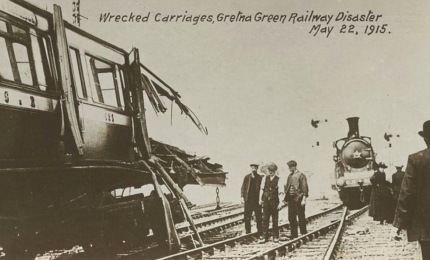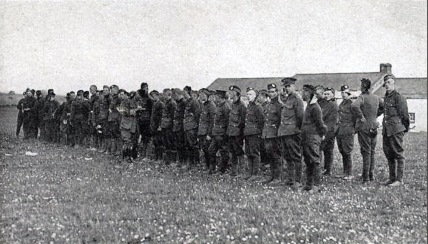The 498 soldiers of the 7th battalion of the Scots Guards must have had mixed feelings as they boarded their troop train at Larbert in Scotland in the early hours of Saturday 22 May 1915. They were off to war as part of the ill-fated Gallipoli expedition. No doubt they pondered their chances of surviving in battle. Yet within three hours, over 200 were dead and a similar number injured in Britain’s most deadly railway disaster at Quintinshill near Gretna Green.
They were victims of a shocking act of neglect by two signalmen and other railwaymen, who failed to notice that signals had been cleared for their troop train even though a local train was standing in its path. The driver of the soldiers’ train had driven Queen Victoria, King Edward VII and King George V, but there was nothing he could do to avoid catastrophe as his train swept downhill at high speed into the local train. The 213 yard long troop train was compressed to a mere 67 yards. A third train ran into the wreckage, killing many survivors. Worse still, the coals of the engines set fire to the gas used to light the ancient wooden coaches causing an inferno that consumed the dead and the living.
A local reporter noted the incongruity of the mixing of human cries for help with the ‘sweet trills of the mavis and blackbird’.
The accident report laid the blame firmly at the door of the signalmen who had forgotten the presence of the local train under their noses in broad daylight, and the fireman of the local who was in the box to remind the signalmen of the presence of the train. The inspector also strongly urged the abolition of deadly gas lighting on trains. (A danger similar to that posed by hydrogen-filled airships.)
The Royal Scots victims were buried in Rosebank cemetery in Edinburgh two days later.
Despite its poignant status as Britain’s most deadly rail crash, the Quintinshill tragedy is less well-known than the Tay bridge disaster or the 1952 Harrow and Wealdstone crash. No doubt the fact it happened in wartime and involved a troop train ensured its anonymity.
PS: there’s an excellent Facebook page about the century commemoration of the disaster at Rosebank cemetery on 23 May 2015.





